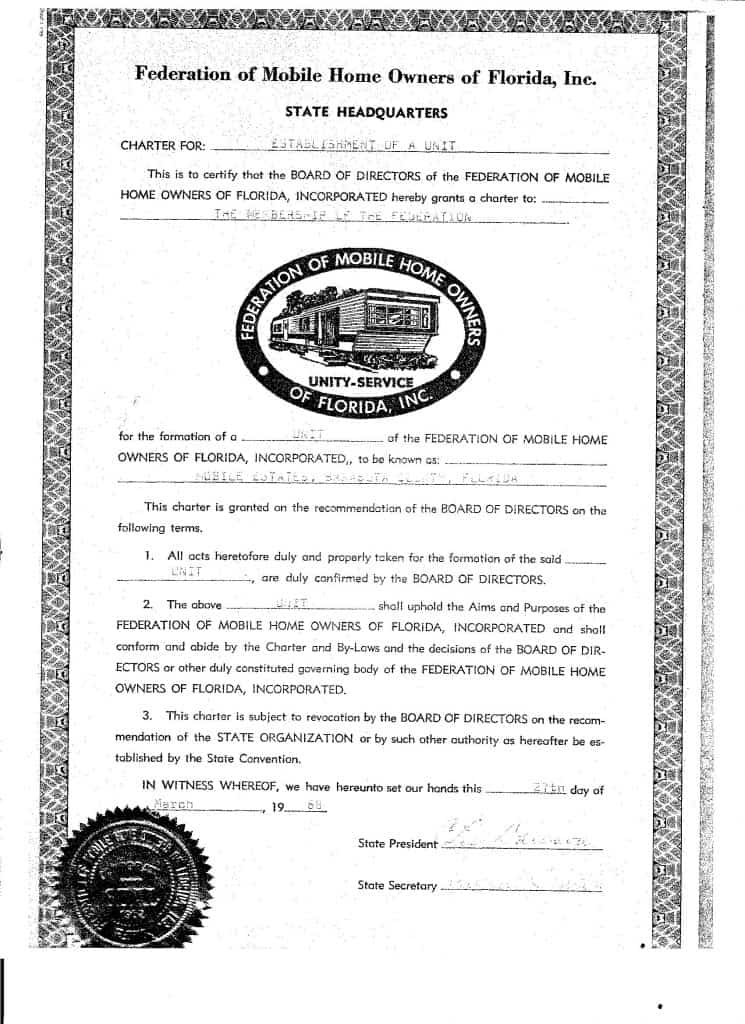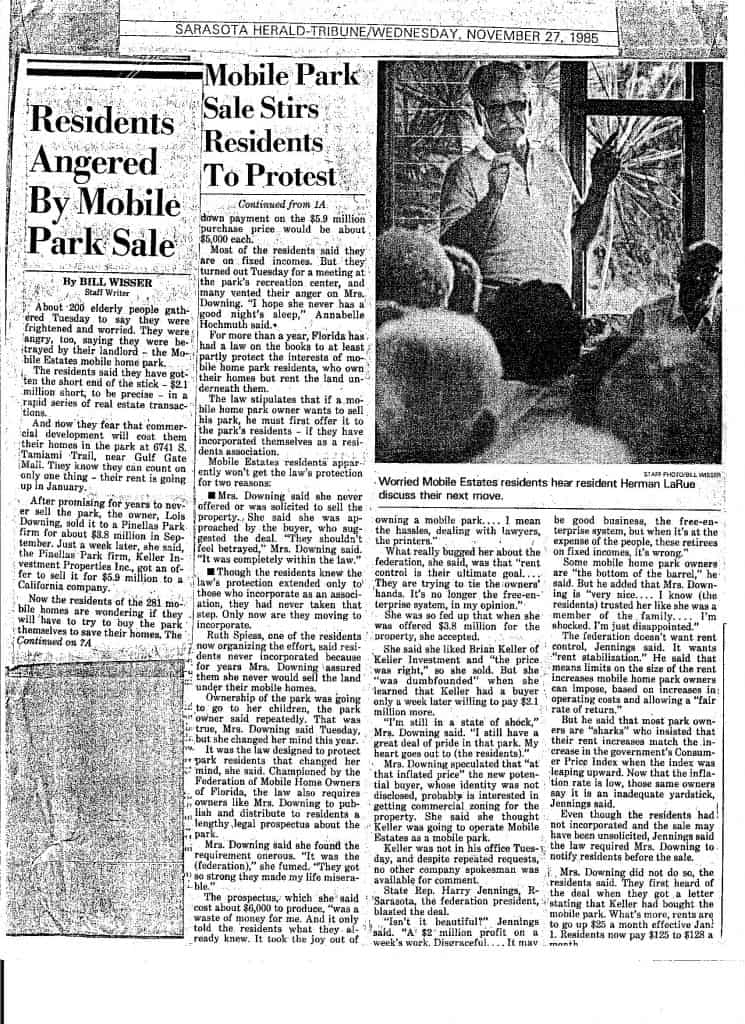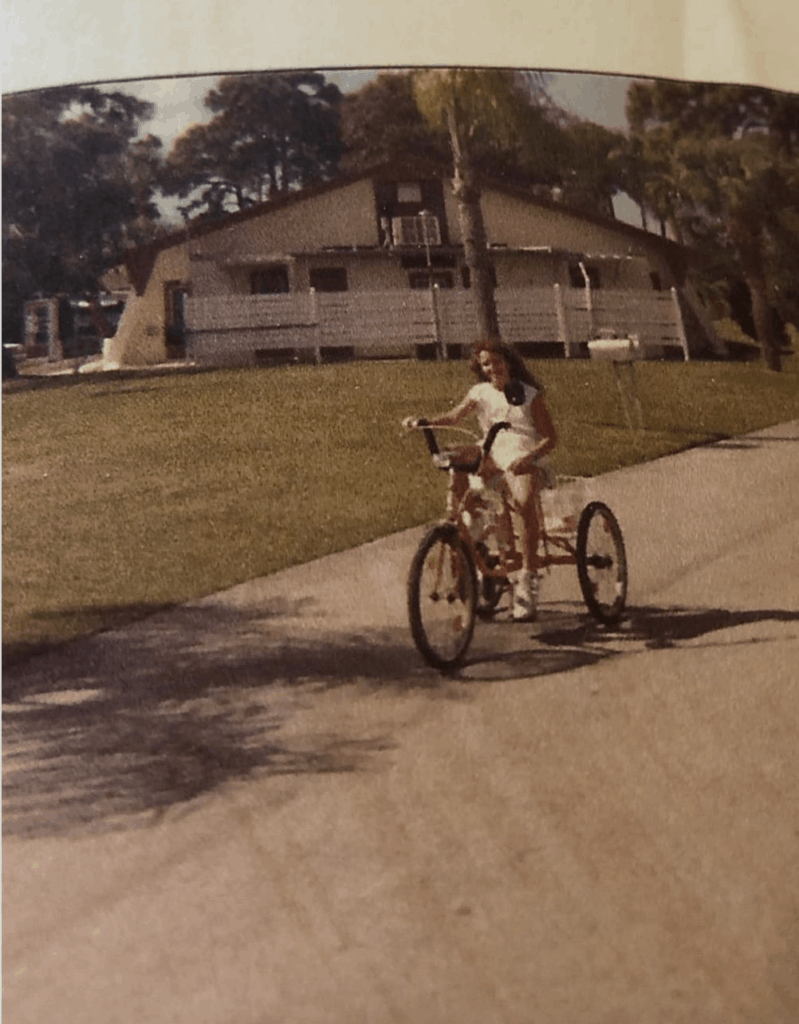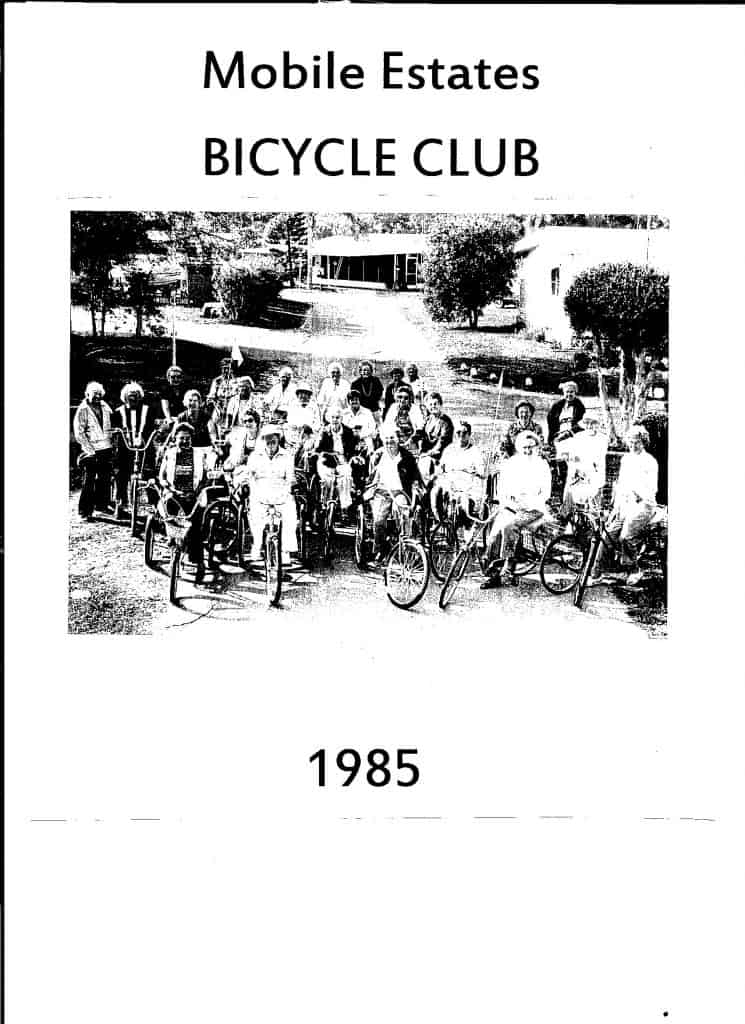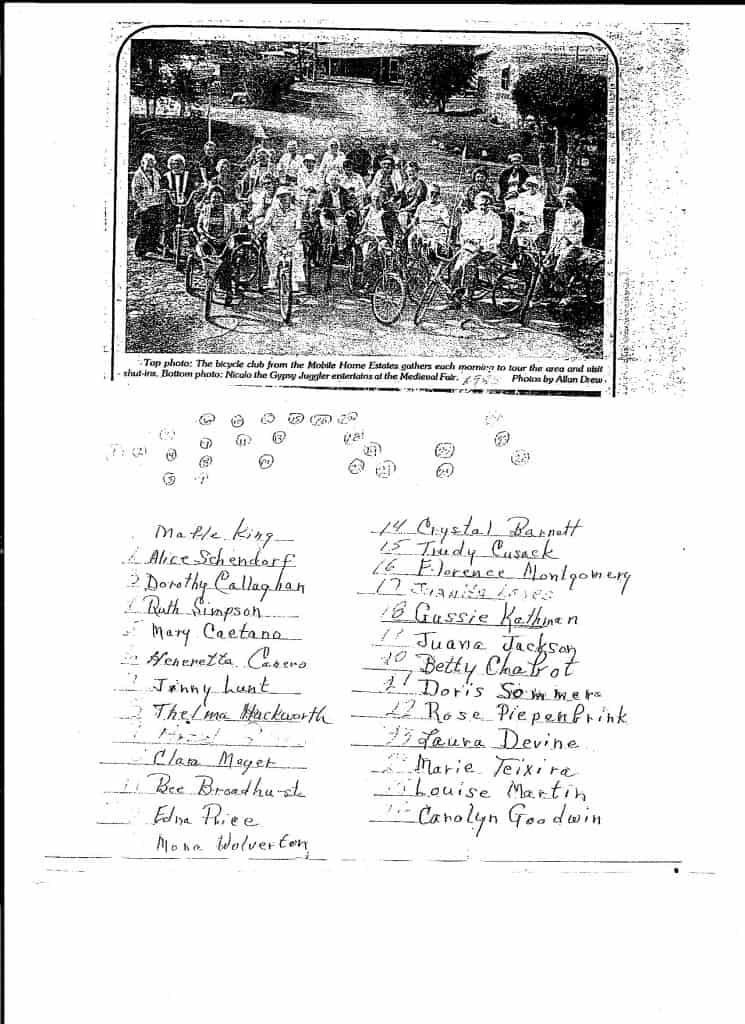Here you will find interesting articles, documents, excerpts, and photos highlighting the history of our community and how we have grown through the years – including the Mobile Estates Corporation Charter of 1968.
HISTORY OF MOBILE ESTATES PARK
Written by Alice Shindorf in or around 1983, with minor revisions
When you look around this area and see Mobile Estates Park, Gulf Gate Mall and Dutch Valley Kitchen, it is hard to envision what this area was like in the early 1900s. The land was a thick jungle of oak trees covered with Spanish moss and palmetto thickets that were impassable. It was hot, muggy, and mosquito- and snake-ridden. Most of the year large portions of the land were under water. The rivers were sluggish, with banks of mud and muck. The settlers had winding foot and horse paths. In the early days there was no water shortage.
This area was alive with bears, wolves, wildcats, deer, armadillos, 180-pound panthers, raccoons, and alligators. This wild pigs and cattle were left here from the Spanish days. Snakes were large and plentiful. One good thing was that black snakes ate rattlesnakes.
The native plants and trees mentioned in Bickel’s book were cabbage palm; the three oaks (water oak, laurel oak, and live oak); the masterful and fertile mangrove, red, white, and black; groves of dark and mysterious cypress; here and there the giant flowering magnolia and its cousin, the bay tree (some so old that four grown men could scarcely lift them); the early swamp maple in fiery Chinese lacquer red; the gray of Spanish moss; air plants and orchids, mottled in red or yellow, some delicate as little bubbles. You could find creatures as strange as the trees and plants: the rare and lonely manatee; the great sea turtles; the slowly turning dolphin; the flashing tarpon; and the kingfish.
In 1947 two sisters and their husbands, Sally and Clarence Clunk, and Zelma and James Lang, purchased twenty-eight acres of land east of Route 41 and south of an open-air theater. At that time there were two homes located to the north, on the property now housing the Gulf Gate Mall, and a 420-acre cattle ranch owned by Jack Bispham to the east, with a milking station located where the Gulf Gate Country Club is now [note: this property, located south of the Gulf Gate Library, has been sold to developers and soon to be under construction]. A second Bispham cattle ranch to the north, where The Landings now stands, was sold to developers in 1948 for ten dollars an acre. The 10,000-acre Palmer Ranch, owned by Bertha Honore Palmer, was just beyond the Bispham Ranch to the east.
Mary Rox, mother of Sally and Zelma, resided where the medical building now stands on 41. She had four apartments; she lived in one and rented out the other three. Considering herself an amateur crafter, she collected pine needles, dried them, and taught pine needle crafting. In the process, she became an expert in her field.
Sally and Clarence Clunk owned a home where the Red Lobster is today. They moved their home when they sold the park in 1957 to Mr. Causiald Sally had ten grandchildren and twelve great-grandchildren. Clarence passed away in 1964, seven years after they sold the park. She married again and took the last name Tew.
Zelma and James Lang lived where Dutch Valley now sits. Route 41 was simply a shell road at the time. To the west was the Pine Shores park and to the north the Five O’Clock Club, a bar and lounge. [Know by its young patrons as the “Bucket of Blood,” the place was known for the many brawls among the young lads who frequented the establishment.] To the south of the park were a hamburger shop and four rows of cottages known as Pine Hurst Cottages. James Lang passed away in 1991. Zelma died shortly thereafter, in 1992.
Overnight parking at the time was located near 41 behind Sally and Zelma’s homes. The Laundry area of today, at the corner of South Mobile Estates Drive and Erdman Street, was the original office. There were two pumps, one near Zelma’s, and the other behind the shuffleboard courts. The office later located to a mobile home at 2042 Champion Street. Rental spaces were ten dollars a month, with tents, campers, trucks, and children, cats, and dogs.
John Houle, a native of Sarasota, was born in 1905 (in St. Petersburg, as that was the location of the nearest doctor). His father was a surveyor in this area, doing all of the surveying on horseback. He took half of his pay in land, so his family settled in what he called Sara Sota, the name of the community when the Post Office established an office there on August 16, 1878. When John Houle graduated from Sarasota High School, four of the lads he graduated with had ridden their bicycles from Venice to school on shell-covered roads every day for four years.
Sarasota had installed electric lights and power in 1910, but it was available only from dusk to midnight, with no lighting on moonlit nights. Finally, in 1911, “Breakfast Service” was provided for early risers – power was turned on daily from 4 AM to 6 AM. “Ironing Service,” from 7 AM to 11 AM, came five years later, on June 9, 1916. Overnight electric service arrived soon after, on November 1, 1916. As for plumbing, John Houle’s father was the first in Sarasota to have a flush toilet installed.
John Houle worked for Palmer Farms and retired twenty years. From 1950 through 1954 he was Sarasota’s County Commissioner. With the exception of Nevada, he and his wife Frances had traveled to every state in the union in their travel trailer. In 1959 they pulled their trailer into Ideal Trailer Park and parked in the lot at 2033 Champion Street. They soon decided to stay and chose 2042 Sun Home Street because it was the only dry spot they could find.
There were a few permanent trailers at that time. One was the Danglers’ at 2025 Champion Street. Lot rent at that time was twenty dollars a month, and ten dollars a month in the summer if you went home a left the trailer behind. The park had changed hands a few times since its start. Clunk and Lang had sold it to Mr. Causiald in 1947 for $65,000. He sold it to two gentlemen, David Rubenstein and Robert Quinn. Walker was the first manager, Boone the second, and Hughes, the third (and best).
Cele and Howard “Shorty” Grant decided to come to Florida after Shorty, at age fifty-one, retired on a disability from U.S. Steel in Chicago. Cele’s daughter told her that if her parents lived in a trailer, she would never come to see them. However, the daughter was the first visitor they ever had.
On November 4, 1959, they pulled into the Ideal Trailer Park with the intention of staying for one week. The only people Cele could remember from that day were Maine Burns and her friend who had a Liberty trailer on the west end of Sun Home Street. Most of the trailers at that time were parked where Red Lobster is now.
A road to the east of 2036 Champion Street went to the south to where the Clubhouse is today, most likely because the well was located there. Cele remembered the Houles because John backed his travel trailer into its spot at 2029 Sun Home Street.
In August of 1960, the Grants decided to put a twenty-foot trailer on their spot. As of this writing, it was still there. They had not yet received their awnings when Hurricane Donna came through. The owner of the motel on 41 where Cele worked insisted that they relocate to the motel for safety. It was a bad storm that took down every sign along 41 and hit Fort Myers hard. When they returned to their new mobile, only one small cloth shade had suffered damage.
The park had telephone booths here and there throughout the park. When someone called the Office, the call recipient’s name was relayed over a loudspeaker; that person could pick up the call at the nearest phone booth. John Houle was instrumental in buying, at wholesale, enough electric wire and tall wooden posts to install streetlights along Sun Home Street.
The property to the south at Reynolds Street and 41, where Toale Brothers Funeral Home is located, was a pine grove. One winter a carnival settled in with their animals. They had two elephants, a couple of bears, a black panther, and many monkeys. Many people came to visit. However, things got bad when some of the monkeys escaped and caused more trouble than raccoons.
Across 41 in Pine Shores, someone raised parakeets. When the thrill of it faded, they turned a large number of them loose. Eventually in Pine Shores, nearly every yard in Pine Shores had a feeder out for them. Ray Shindorf said that even into the late sixties it was “a sight to see”: a dozen or more parakeets of different colors sitting on the telephone wires. But John Houle told of seeing close to one hundred and watching as they prepared to fly south with the robins.
One winter, a man called Texas Jim moved to Fruitville Road and started a rattlesnake farm. He milked and sold the venom as medicine. John Houle too was in the medicine business. Having access to honeybees, he would identify the area of a patient’s body that was affected with arthritis – especially the hands and knees – and have bees sting that area, claiming that 200 bee stings were as effective as on snakebite. He would provide six bee stings on the knees to provide relief for a period of time. I (Alice) know this to be true because o friend in Michigan provides me with a bee sting on each thumb, and this brings me relief from pain.
Maxine Burns relates that she came into the park in 1956 to visit her girlfriend who had a Liberty trailer on the west end of Sun Home Street. She and her husband Orris returned in 1957 and put in a trailer at the corner of South Mobile Estates Drive and Vagabond Way. Orris Burns worked at Sears for five years; Maxine worked at Woolworth’s and retired only when the store closed. Putting her earnings to good use, Maxine is the proud owner of a new Mobile Home recently put in on her lot.
The Office at the time was smaller than our current clubhouse. In the southwest corner was the shower room. Washing machines were outside on the east end of the clubhouse where the kitchen is now, with a roof-over. The clotheslines were located at the site of our current swimming pool.
A woman named Fay Foist owned three small houses on Peerless Way and rented them out. She was a short plump lady who always wore gingham dresses, and a hat of the same material. Liked by everyone, she was called Grandma Bush. There were fruit trees everywhere but no homes east of Maxine’s, just deep grass and trees, and so many animals, they didn’t know what to call some of them.
Mamie Foltz came into the park in 1963. She was told to go onto South Mobile Estates Drive and pick out a spot. When she did, all she could see were trees and knee-high grass. Maxine Burns’ trailer was the only one up front, and Helen Franks was over at 2069 Detroiter Street. When Mamie appeared at the Franks’ door, announcing herself as their new neighbor, Helen replied in her German accent, “Hurry up! We’re so lonesome here.” Mamie had her new Mobile brought in from Fort Myers for $125.00. The cost of the Mobile was $6000.00.
Norbert Erdman* came to Sarasota in 1964 from Milwaukee and purchased the Ideal Trailer Park in 1965 from Rubenstein and Quinn. Erdman changed the name of the park to Mobile Estates Park. He sold the land that fronted on 41 to the Red Lobster and purchased a strip of land for a front driveway and, by 1967, extended the size of the park to include the new Glenwood and Trotwood area.
Trudy and Harold Fog retired in 1966 and came to Florida to spend the winter in Happy Haven in Osprey. The following year Trudy, now a widow, pulled her travel trailer into Mobile Estates and picked out a lot on Trotwood that was covered with trees and high grass. She traded in her travel trailer for a new Mobile Home that she still lives in at 2115 Trotwood Drive. Two and a half years later, Trudy married Warren Cusach. Trudy did more than her share to make Mobile Estates a good place to live.
Jane and Charlie Sheets came into the park in 1969. Jane’s girlfriend had given her the keys to her Mobile Trailer at 2049 Champion Street so that Charlie could recuperate from a bad car accident. The rent at that time was $30.00 a month, with a heat and lights charge of $14.00 a month.
Everyone got their mail, had potlucks, and played bingo and cards in the hall [clubhouse]. The men put on some great pancake breakfasts. You had to wear proper dress (no shorts) when you went to the hall.
When Maxine, as spokesperson, approached him about putting in a swimming pool, Mr. Erdman declined, saying no one would use it. As a concession, he put in a shuffleboard court, which became very popular. Teams formed and competed against Pine Shores teams. This continued well into the 1980s.
Jane and Charlie returned to Mobile Estates Park the following year, and this time put in a new Mobile Home at 2042 Champion Street, the site formerly used as the Office. In November of 1973 they sold their Mobile to Maud Miller, who lived across the street with Ruth Miller ((no relation), and purchased the Mobile Home at 2094 Glenwood Drive from Clarence Boyd’s sister.
Clarence and Vivian Boyd had been spending their winters, with their Travel Trailer, in different parts of Florida. When they retired, they came from Cambridge, Ohio to Mobile Estates Park in 1968. They rented at 2049 Sun Home Street until 1971, when they put in a new Mobile Home at 2079 Glenwood Drive. They had fallen in love with Florida.
Rowland and Carol Chapman, from Michigan, came into the Ideal Trailer Park the Sunday before Labor Day in 1953, back when Sally and Clarence Clunk and Zelma and James Lang owned it. The Chapmans had three children. They put in the first ten-foot wide Mobile Home in the Park, at 2055 Champion Street at the corner of Parkwood Drive. Richard Henderson now owns it [at the time of writing].
Lewis and Mable Reid (parents of Carol Chapman) lived next door at 2057 Champion St. They owned and operated the Chappie Carpet & Floor Shop at 2744 Stickney Point Road before their son Kenneth took it over. Ken married Pat, a young woman from Japan, who enjoyed riding her three-wheeled bike to and from the laundry, and babysitting housecleaning while the other family members worked in the carpet shop.
The Chapmans would gather pinecones and burn them in a pot-bellied stove. Ken fished for guppies in the pond in the Park (which no longer exists) and sold them.
In 1965, when Carol was in the hospital for the birth of her daughter, Rowland received a letter from the Park Office informing the family that, because new rules did not allow children or dogs, they had to move. And Carol cried for days because she had to give up her dog. This must have been the time that Mobile Estates Park became a 55+ Adult Park.
—– END —–
* Erdman Street is named after this owner. All other street names, aside from North and South Mobile Estates, are named after brands of trailers of that period.
Editor’s Note: The above history is as much a memoir as it is a history. Although the historical references could be challenged in places, the story is as accurate as Alice Shindorf ‘s resources allowed.
RECOMMENDED READING / VIEWING:
The Story of Sarasota, book by Carl Grismer (1946) — https://digital.lib.usf.edu/SFS0036425/00001
A Trailer Estate of Mind, article by Cole Zelznak (2018) — https://ncfcatalyst.com/a-trailer-estate-of-mind/
The Life and Times of John and Mable Ringling, PBS video (2006)– https://www.pbs.org/video/wedu-specials-life-and-times-john-and-mabel-ringling/
[ngg src=”galleries” ids=”40″ display=”basic_thumbnail” thumbnail_width=”150″ thumbnail_height=”200″ number_of_columns=”4″]MOBILE ESTATES IMAGES
